2017 Polaris 600 Voyageur 144 Review
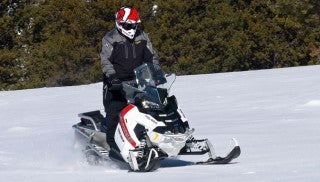
The most utilitarian of Polaris’ new niche series of 144s
When Polaris created its new-for-2017 series of “144” sleds, it engineered a completely new chassis and a new rear suspension to churn under it. You can find examples of this handiwork across the 2017 Polaris model niches, including an RMK, a Switchback, two Switchback Assaults and the 600 Voyageur 144.
Engine Type:Horizontal In-line
Cylinders:2
Engine Stroke:2-Stroke
Valve Configuration:Reed Valve
Displacement:599 / 36.6
Starter:Electric
Turbocharged:No
View Full SpecWe find it interesting the confidence Polaris has in its new set up. The new AXYS 144 chassis and new IGX (Ideal Geometry X-Over) 144 rear suspension serve as the backbone of sleds designed for quite different segments. The 600 Voyageur 144 meets the needs of the occasional recreational rider who has a greater need for a more utilitarian snowmobile. The 600 Switchback SP and Switchback Assaults are for riders who ride off trail more than on and demand go-anywhere (except the extreme steep and deep) performance. Closest in performance might be the 600 Switchback SP and the Voyageur 144. But there are key conceptual differences.
Admittedly after we test rode the Switchback SP, we failed to see the need to ride or spend much time with the 600 Voyageur 144 we had scheduled for evaluation. But we are snowmobile test professionals and that’s our job. Thankfully we took the time as we came away with an understanding of how just a few differences can effectively create a totally different sled. The SP and the Voyageur are similar, but really quite different.
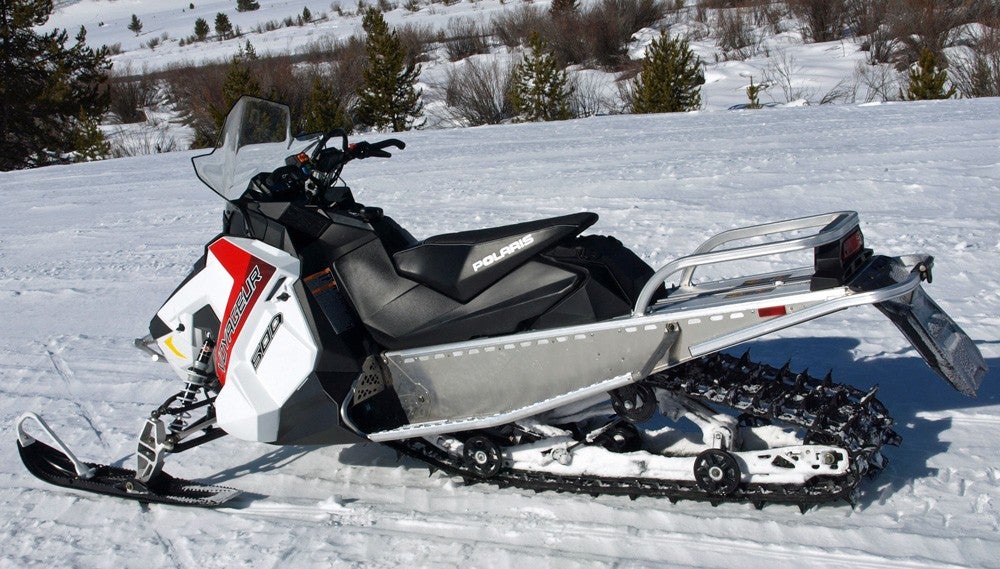
Polaris’ all-new AXYS 144 platform borrows from the RMK series as does the new IGX 144 rear suspension.
We’re not going to be drawn into the “which is better” debate here. In truth we liked the two sleds equally well and precisely for their differences. On the surface the similarities should almost negate the differences. Both feature the well-proven Polaris-engineered Cleanfire 600cc liquid-cooled two-stroke twin. In our book, we rank it right alongside Ski-Doo’s Rotax-built 600 ETEC. The Ski-Doo with its electronic direct injection should be cleaner and more fuel efficient, but the Polaris “6” is no slouch. It’s crisp at the throttle due to a semi-direct injection Cleanfire system and computerized fuel mapping. The two twins should be safely in the 120-horsepower window. The Cleanfire works well across various Polaris platforms, this 144 series as well as the Rush and Pro-XC Switchback models. Unless you’re looking for pure 800cc power, the Polaris “6” isn’t a disappointment. Especially when you note Polaris engineering controls its output with a time-honored P-85 Polaris drive clutch and a Polaris-spec Team LWT driven. One thing Polaris has been very good at over the decades is getting an engine’s power to the track. These 600cc 144s are no exception as throttle roll-on in off-trail situations is smooth with no surprises like low end bogging and such.
The surprise with the Voyageur is how well it handles. It should handle moderately deep fluff well as it is essentially the same as the new 600 RMK 144, complete with the adjustable front end and Gripper skis that can stretch ski stance from a narrow 39-inch width out to a full 41 inches. Most of the other 144s, including the SP 144, in the 2017 Polaris line feature Pro-Steer skis and a fixed 42.5-inch stance. We grew very comfortable with the SP, but kind of rediscovered old-style riding habits with the narrow-stanced Voyageur. After the first few corners we relaxed and crawled all over the Voyageur’s AXYS Performance saddle, shifting vast amounts of prodigious avoirdupois from side to side to balance the handling. It’s what modern hard riding vintage riders do to maximize sled handling. But, today’s sleds have much of that “old” time feel effectively engineered out, having the sled do what we used to do with our weight shifts. The Voyageur responded well to rider shifting and we found ourselves seeking out tighter turns and inputting more throttle when we did. Both the Switchback SP and the Voyageur allow you to enjoy this type of riding, but we found the Voyageur more fun. We imagine if you cinched in the skis to their 39-inch stance, you’d get even more feedback.
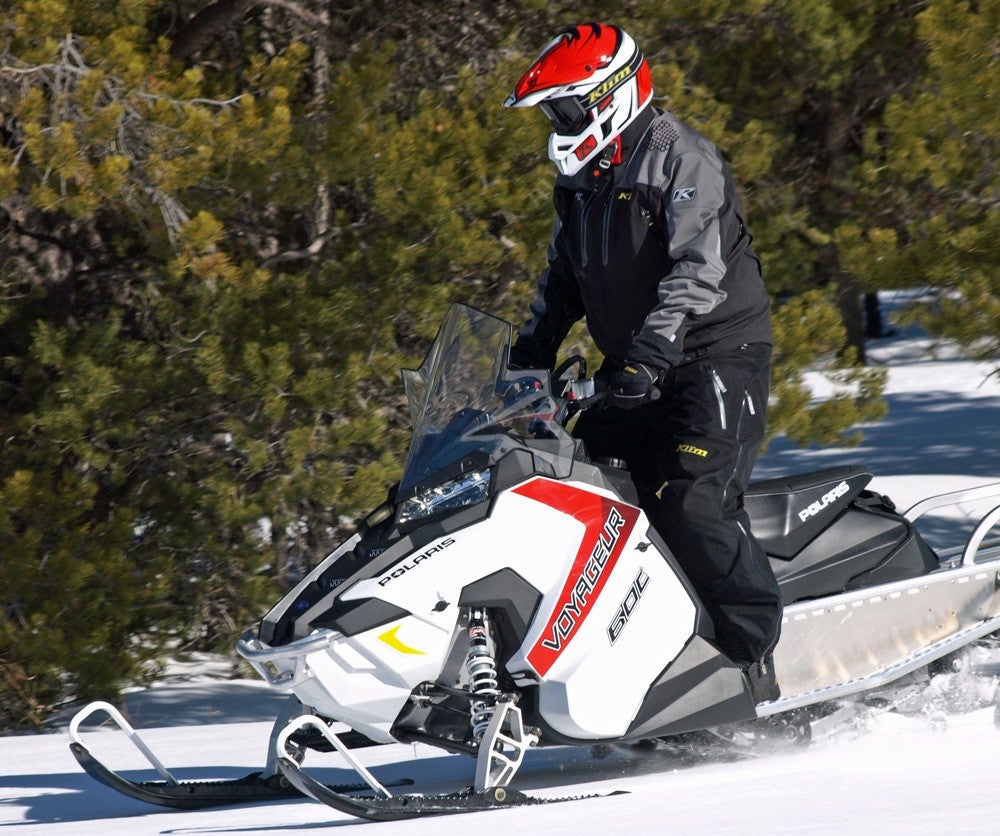
You can set the Voyageur’s front suspension stance from 39-inches to 41-inches to accommodate your needs, be it riding through the trees or cruising groomed trails.
Another thing we noticed with the Voyageur is that, of the 2017 crop of 144s, it has the most budget-priced shock package, which it shares with the 600 RMK 144. The 600 Switchback SP 144 gets an upgrade to Fox IFP shocks while the Assault 144 goes all out with premium Walker Evans compression adjustable shocks. For most crossover or trail riding, the vast majority of Voyageur riders will be completely satisfied with the RydeFX MPV shocks that are used on the AXYS front suspension and the IGX 144 rear unit.
A time-tested shock, the RydeFX MPV features compression adjustability via a screw adjuster. The shock’s gas cell should provide consistent bump-smoothing performance over its life cycle. The design includes a low fade orifice to seamlessly transition from low speed operation to high speed handling. A standard micro cellular urethane bumper is designed to compress and eliminate hard bottoming.
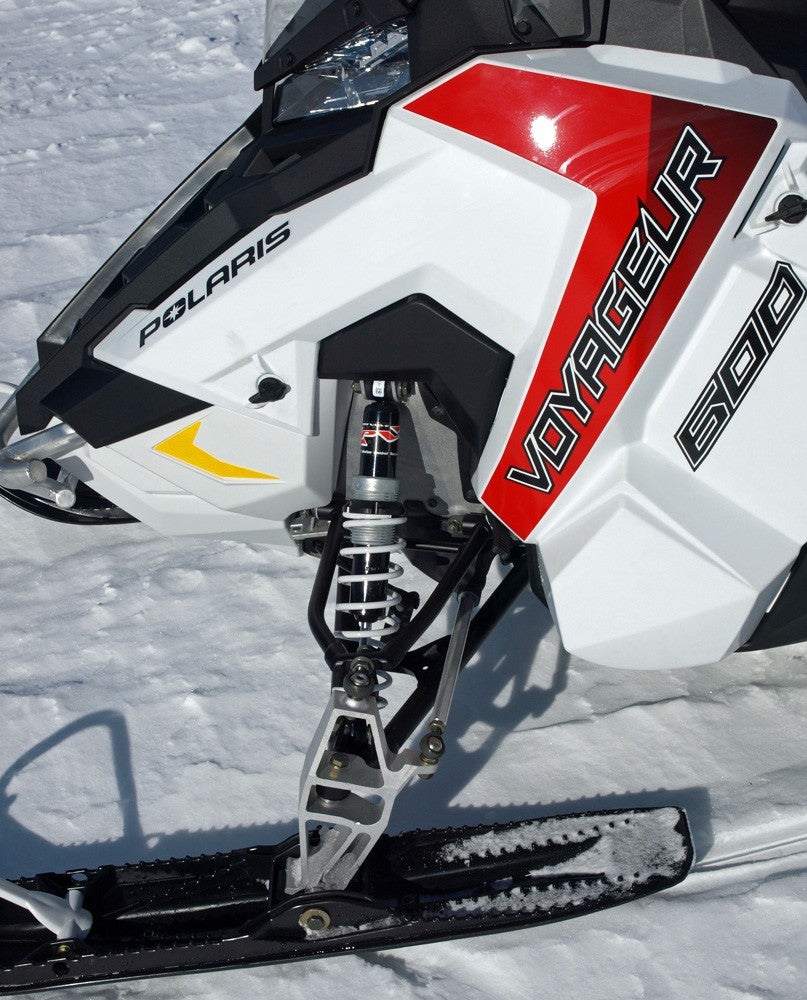
The Voyageur’s RydeFX MPV shock package features compression adjustability via a screw adjuster and a gas cell that should provide consistent bump-smoothing performance over its life cycle.
Polaris put a great deal of engineering effort into the new IGX 144 rear suspension, which is used in the Voyageur as well as the high performance 800 Switchback Assault 144. Shock and spring calibrations give the IGX 144 up to 43% more front torque arm travel than previous designs. This suspension is said to be RMK-inspired for off-trail capability, but it proved itself as an adept on-trail suspension as well. We were pleasantly surprised with how quickly it managed to turn into corners, backing up Polaris’ claim that its “…lighter, tipped rail beam design gives the sled a nimble feel.” It does for certain!
If you compare the specifications of the Voyageur to the 600 RMK 144, you’ll note many similarities as well as a US$500 premium. But that can easily be traced to the Voyageur’s standard electric start, which is an option with the RMK 144 and the SP as well. For a utility niche sled, the 600 Voyageur 144 offers quite a bit. Obviously there is the benefit of adjustable ski stance, which can be widened if you primarily travel trails or taken in if you need to flit between trees in a forest. You can grab on to the standard “mountain” strap to help you maneuver in those conditions or work a hillside. The Voyageur comes with storage integrated into the under seat area. And, of course, what serious utility model doesn’t have a cargo rack? Electronic push button reverse makes getting out of tight situations easier. And there is the RMK-based PowderTrac hybrid running boards with added clearance to increase snow evacuation. Although based on the RMK style, these running boards were designed specifically for the AXYS 144 platform and are both wider and flatter with an upward taper at the rear for improved mobility in turns.
That design will prove helpful if you take the Voyageur into the boondocks as its standard 144-inch 2.0 Series 4 track offers a good compromise between on- and off-trail performance. The stiff lug base holds up for grip on hard packed groomed trails while the softer and more flexible tips work better at applying traction in deep snow.
We can’t help but admire Polaris’ engineering and marketing teams for coming up with such a versatile design. The AXYS 144 platform and the IGX 144 suspension form the basis for a very good set of new 2017 Polaris models. Our favorites have to be the SP and the Voyageur. We like the 600 twin’s performance for flatland riding and we like the fun handling of the sleds. We’d probably opt for the SP over the Voyageur, but we like the idea that the Voyageur gives us standard electric start, optional ski stances and better on-board storage options. So, maybe we’d go with the Voyageur. We don’t know; it’ll be your choice.
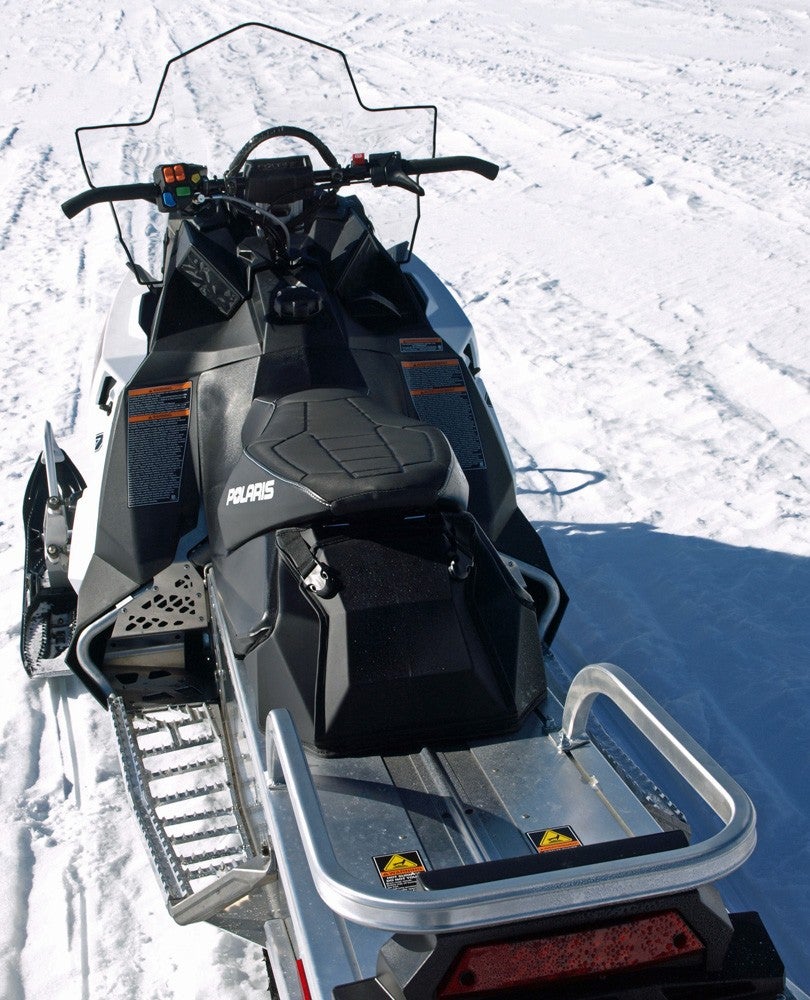
The 144 platform allows ample room to place a comfy seat, onboard storage, cargo rack and tipped rearward snow evacuating running boards.
2017 Polaris 600 Voyageur 144 Specs
| Engine | Polaris Liberty 599cc twin cylinder 2-stroke; liquid-cooled; Polaris Cleanfire semi-direct electronic fuel injection; two-into-one exhaust with variable exhaust valve; CD ignition |
| Horsepower | 120 (Estimated) |
| Drive | Polaris P-85 drive with Team LWT driven clutch |
| Front Suspension | AXYS dual A-arm with RydeFX MPV shocks; 9.3-inches of travel; Gripper skis |
| Rear Suspension | NEW: IGX 144 parallel rail slide suspension with RydeFX MPV suspension shocks; 16-inches of travel |
| Length | 127.0 in |
| Width | 45.0 in |
| Height | 54.5 in |
| Ski Stance | Adjustable 39-41 in |
| Track | 15 x 144x 2.0 Series 4 |
| Weight | 486 (estimated dry weight) |
| Brake | Polaris AXYS radial disc system |
| Features | STANDARD: Gripper skis; electric start; electronic reverse; AXYS performance seat; digital speedometer/tachometer display; 3.5-inch fixed riser; AXYS 20-inch tall windshield; rear rack & tow hitch OPTIONS: storage options; mirrors; 12-volt outlet |
| Fuel Capacity | 12.0 US Gal |
| MSRP | US$11,199/C$12,999 |



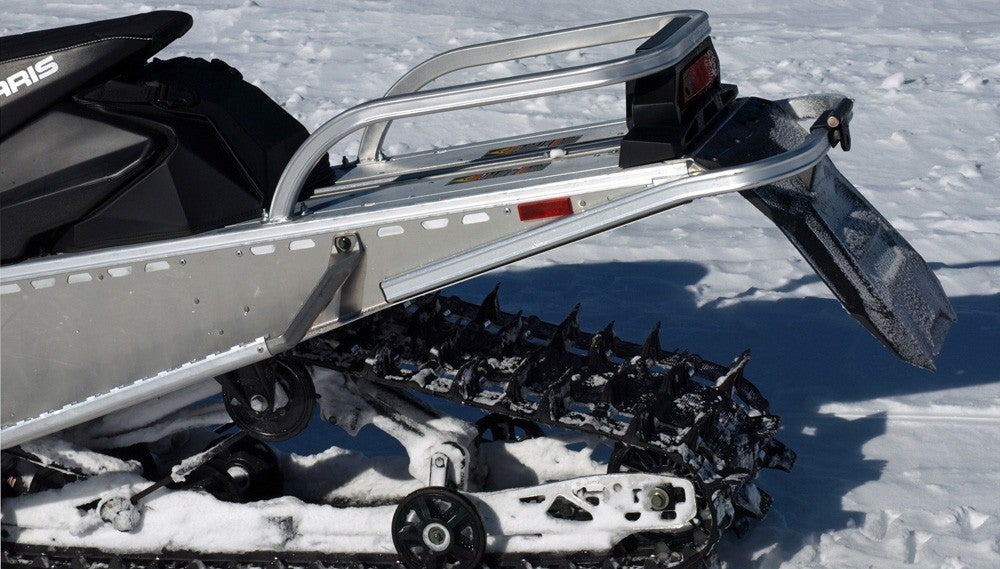
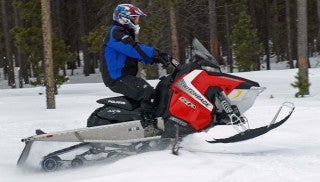




 Your Privacy Choices
Your Privacy Choices